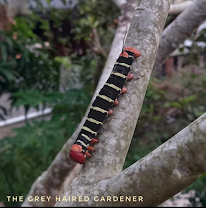Photo of a bunch of beautiful yellow frangipani flowers in the garden
Frangipani (Plumeria) plants are the crowning jewels of my garden. Their vibrant blooms, with brilliant bursts of color against lush green foliage, breathe life into the backyard. But as much as I adore these plants, it seems I’m not their only admirer!
A particular set of guests—the larvae of the moth Pseudosphinx tetrio—love my frangipani even more. These striking caterpillars sport black bodies with yellow rings and a reddish-orange head, a vivid color palette that serves as a warning to predators: as if saying “Stay away—I’m toxic!”
On their rear end, they flaunt a black, horn-like structure, adding to their intimidating look. At around 4 inches long, they’re hard to miss once you spot them.
And their appetite? Absolutely insatiable. In just days, these voracious feeders can strip a mature frangipani tree of all its leaves. Sometimes, their presence is only betrayed by the telltale mass of frass (faecal matter) scattered beneath the tree. If food runs low, they’ll even gnaw on the tender tips of young stems.
Oddly enough, I’ve never seen the adult moth. Described as brown with grey and white markings, it seems to live a far more discreet life than its flamboyant larvae.
Despite their ravenous tendencies, these caterpillars add an intriguing layer of drama to my garden. Watching nature’s interactions—even the ones that nibble on your favorite plants—reminds me of the delicate balance at play. After all, every garden comes with its own wild stories!
Happy Gardening!




.jpg)


No comments:
Post a Comment